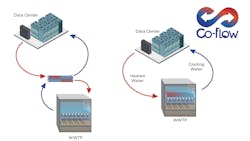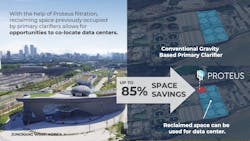Co-Flow Initiative to co-locate WRRFs and data centers
Tomorrow Water and its parent company, BKT Co. Ltd., producers in wastewater treatment and sustainable waste management, have recently announced the launch of their Co-Flow Initiative. The initiative aims to help in developing co-located water resource recovery facilities (WRRFs) and data centers.
Tomorrow Water's research finds that data centers can improve their power and water use effectiveness when co-located with existing and planned WRRFs that have treatment capacities of over 10 million gallons per day. According to US EPA's Clean Watersheds Needs Survey (CWNS) data, by 2032, there will be an estimated 900 WRRFs in that capacity range in the United States alone. Tomorrow Water estimates that between 900 and 1,500 data centers could be built on these sites by just retrofitting primary clarifier into space saving compact advanced filtration system.
The United States is home to the world's greatest number of data centers, accounting for 70 billion kWh of electric energy or 2 percent of the country's overall annual energy consumption. So much heat is generated from these data centers that 30-50% of their operating costs are due to cooling systems. As future demand for data centers grows for cloud computing, big data, and artificial intelligence, the initiative seizes an opportunity to integrate two vital industrial systems and maximize efficiency.
Challenges in locating data centers include securing suitable sites that can provide a stable power supply relative to IT capacity demands, environmental regulations, employment, security, and infrastructure. The energy and water savings created by the Co-Flow Initiative will help address multiple crucial infrastructure needs while also minimizing environmental impact and land use.
"As our society moves toward digital transformation, data processing demand becomes crucial in all aspects, requiring more data centers near highly populated urban area,” said Tomorrow Water's CEO, E.F. Kim. “These data centers will typically consume more fossil energy, which would aggravate the already worsening global warming situation. By having the data center in the WWRF, cooling will become easier, saving energy."
SOURCE: Tomorrow Water, via PRNewswire

